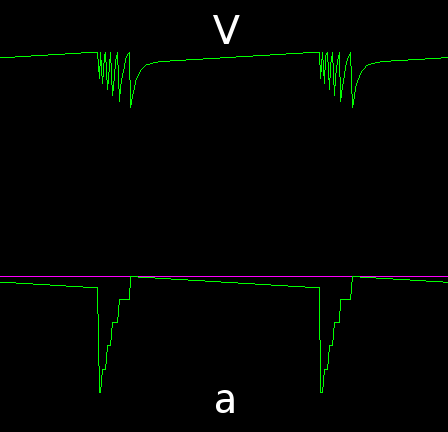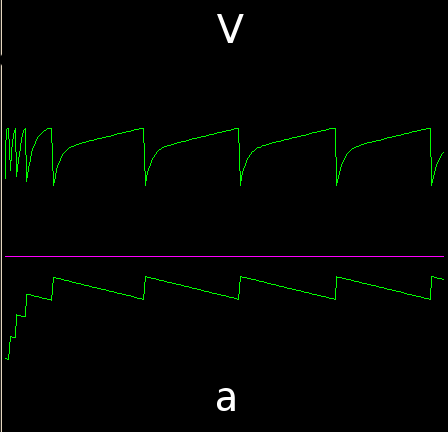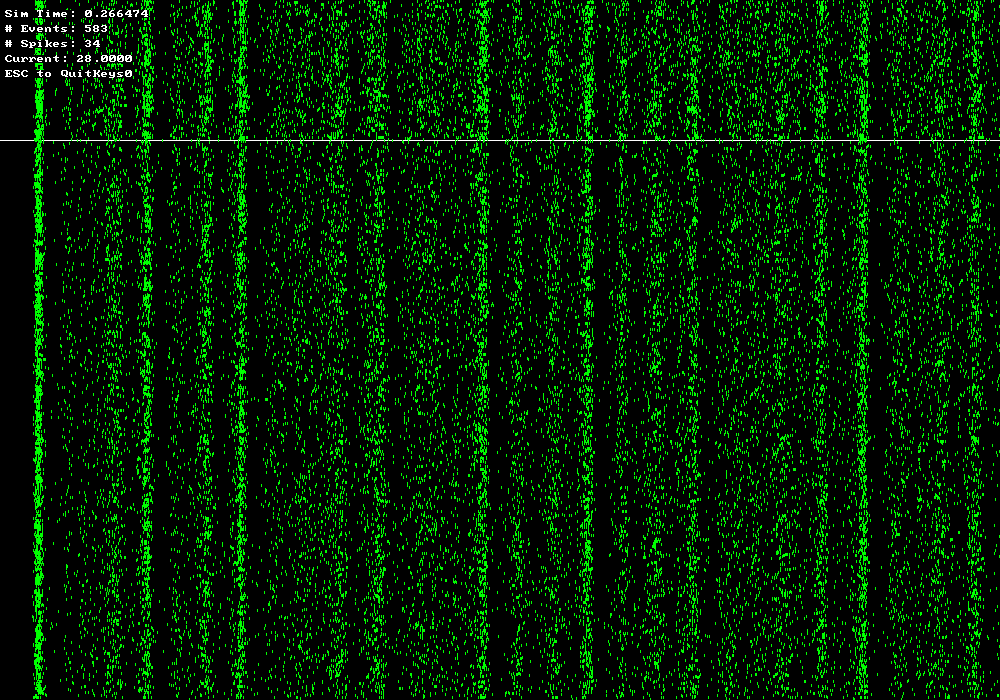An Event Based Neuron Network Model
By Pavel Sountsov
Introduction
There are two primary methods of simulating complex neural networks.
One is to describe each neuron as a set of time dependent differential
equations, and then simulate the system by advancing the time by either
a fixed or a variable timestep. The other method involves solving those
differential equations and then using those solutions to advance the
system to the next state discontinuity, such as the spiking of a
neuron.
The timestep method has the advantage of being relatively easy to
simulate and formulate. In terms of formulation the differential
equations can be obtained from mathematical analysis of the phase
diagrams of neurons that are being simulated, or voltage clamp
recordings of individual ions in biological neurons. The simulation can
proceed through the use of Euler or Runge-Kutta integration methods,
preferably using the implicit versions of those algorithms for greater
stability of the often stiff systems. A disadvantage of this method is
that, if the timestep is large enough, the quantization of the
simulation may adversely affect neural nets where spike timing is of
importance. To prevent that small timesteps are often used, but this
leads to computational inefficiency because many more calculations have
to be done.
The event based method has the advantage of the complete lack of
quantization of the simulation. Each event, each spike happens at the
exact time it is supposed to happen given the system description. Also
if the system is quiescent, that is, the ratio of times of inactivity
to the times of activity is relatively high, the simulation speed can
be greatly increased. This depends on the system however, and since
this method requires more computation per system update this favourable
ratio can often not be achieved. A great disadvantage of this method is
that the closed form solution of the differential equations is often
impossible. In fact, no biologically realistic neuron is simple enough
to solve analytically. Simpler neurons, such as the integrate and fire
neuron, however, can be solved and thus benefit from this method
immensely. In the end, if these disadvantages are surmounted, this
method is almost always preferred.
One disadvantage of the integrate and fire neurons is that they do not
exhibit too many of the features of realistic neurons, such as
bursting, variable threshold et al. Thus, a more complicated model is
preferred.
Model Description
For this project I sought to create an event based simulation of a
slightly more complicated neuronal model. Since it is far easier to
tweak the model while running the simulation using the timestep method.
The model has three state parameters: V, a, I. V roughly represents the
membrane potential of the cell. a governs the second-dimensional
features of the model such as bursting and spike rate adaptation. I
represents the decaying synaptic current. In addition to the state
variables, the system is described by 11 more constants, which are
letters K, L, M, N, P, D, C, E, F, Ic and d. Aside from Ic, which
represents the constant current input into the cell, the constants'
meaning is somewhat abstract. The equations that describe the system
are as follows:
V' = -KV + Ic + I - a
a' = -M if a > N (Ic + I)
a' = M if a < N (Ic + I)
I' = -d if I > 0
I' = d if I < 0
Also, there are two threshold based state switches.
One for V:
if V > P then
V = D
a = a + F
And one for a:
if a > C
a = E
The model can replicate many styles of spiking, such as tonic and
phasic spiking, tonic and phasic bursting and others. Seemingly this
model does not produce nice spikes after it reaches threshold, but
through testing of biologically realistic systems it was found that the
exact behaviour of the system during the spike is of limited
importance. Thus, if the one so prefers, one can add some vertical
lines at the spike times. Here are some sample traces from the model.


To convert this model to an event based simulation method, one has to
solve all of those differential equations. This process is a little
complicated, but doable. For completeness's sake the full form
solutions are as follows. Note that two new variables are introduced,
curd and curM, which represent the current values of d and M, given the
value of I and a respectively (see the state descriptions above). Also,
there is are a set of free variables that depend on the initial
conditions, these are O, a0, I0. t is the independent variable. e is
the base of the natural logarithm.
V = (curd - a0 K + I0 K + Ic K - curM) / K^2 + (curM - curd) t / K + O e ^ (-K t)
a = a0 + curM t
I = I0 + curd t
The event based simulation method depends on solving those equations
for specific times at which the equations above change their form.
Besides the two threshold transitions that are present in the model,
there are two more state changes. Also, the equations must be updated
each time the I is increased due to the synaptic input from another
cell. Namely, the times when curM and curd change sign. This leads us
to a total of 5 times that are generated at every model update, one
time for each future event change. Thus, the general modus operandi of
the model would be to find all of those 5 times, then pick the one that
happens the soonest, update the time by that amount, find the 5 times
again and so on. The exact formulas won't be provided, and can be
examined within the model implementation. .
Normally, an event queue would be used, but for this particular
implementation a simpler method is used. Each cell is updated at a
fixed time interval, while keeping track of the time elapsed since the
last event. An model update is triggered once the time elapsed matches
or exceeds the time obtained from the previous event update.
Sample Neural Network Implementation
To test this model a simple network simulating the cerebral cortex was
created. It consists of 1000 of interconnected cells. One fifth of them
are faster spiking, inhibitory cells. The rest are slower, excitatory
cells. Each cells is connected to 5 other cells randomly choses from
the neuron population. Also, the cells are set to get random current
injections, simulating the input from the basal ganglia. The C++ source
code implementation is given below.
Download Sample Implementation
This network exhibits some rhytmic activity as can be seen from the
images.

Copyright 2008 Pavel Sountsov
Contact: ps335 at cornell.edu


